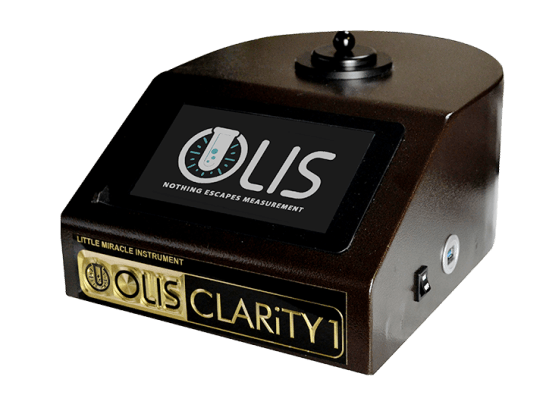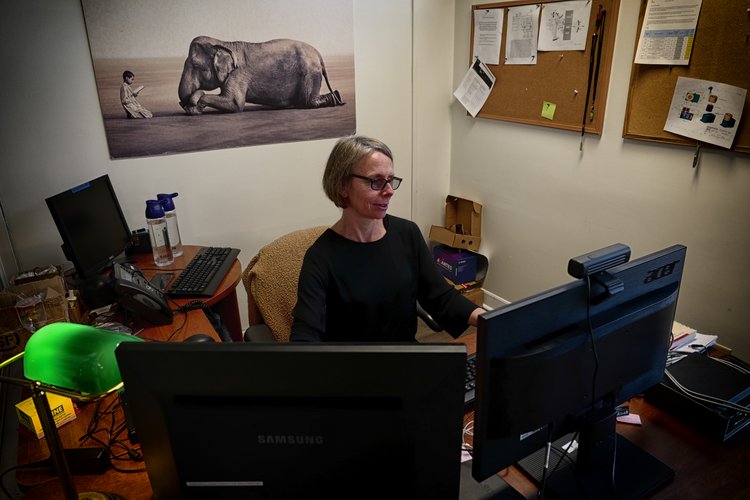Uv/vis/nir for Dummies
Uv/vis/nir for Dummies
Blog Article
The smart Trick of Circular Dichroism That Nobody is Discussing
Table of ContentsThe Ultimate Guide To Uv/visThe Uv/vis/nir Ideas4 Simple Techniques For Uv/visWhat Does Spectrophotometers Do?Spectrophotometers for BeginnersGet This Report about Spectrophotometers10 Simple Techniques For Uv/visFascination About Uv/visWhat Does Uv/vis Mean?The 5-Minute Rule for Uv/vis/nirUv/vis/nir - An OverviewSpectrophotometers for BeginnersExamine This Report on Uv/vis
It is then scanned through the sample and the reference options. Portions of the event wavelengths are sent through, or shown from, the sample and the recommendation. Electronic circuits convert the relative currents into direct transmission portions and/or absorbance/concentration values.The transmission of a referral compound is set as a standard (datum) value, so the transmission of all other compounds are recorded relative to the preliminary "zeroed" compound. The spectrophotometer then converts the transmission ratio into 'absorbency', the concentration of particular components of the test sample relative to the preliminary compound.
Considering that samples in these applications are not readily offered in big amounts, they are especially fit to being examined in this non-destructive method. In addition, valuable sample can be saved by using a micro-volume platform where as little as 1u, L of sample is needed for total analyses. A brief description of the treatment of spectrophotometry consists of comparing the absorbency of a blank sample that does not include a colored substance to a sample which contains a colored compound.
Little Known Facts About Circularly Polarized Luminescence.
In biochemical experiments, a chemical and/or physical property is chosen and the procedure that is used specifies to that residential or commercial property in order to derive more information about the sample, such as the quantity, pureness, enzyme activity, etc. Spectrophotometry can be utilized for a variety of techniques such as determining optimal wavelength absorbance of samples, determining optimum p, H for absorbance of samples, determining concentrations of unidentified samples, and identifying the p, Ka of various samples.: 21119 Spectrophotometry is also a handy procedure for protein purification and can also be used as a method to create optical assays of a substance.
It is possible to understand the concentrations of a 2 part mixture utilizing the absorption spectra of the basic solutions of each component. To do this, it is needed to know the termination coefficient of this mix at two wave lengths and the termination coefficients of options that consist of the known weights of the two elements.

The Facts About Circularly Polarized Luminescence Revealed
A lot of spectrophotometers are used in the UV and noticeable regions of the spectrum, and some of these instruments likewise operate into the near-infrared Area. The concentration of a protein can be estimated by measuring the OD at 280 nm due to the presence of tryptophan, tyrosine and phenylalanine (https://soundcloud.com/julieanndesalorenz30606).
Nucleic acid contamination can likewise interfere. This method needs a spectrophotometer capable of determining in the UV region with quartz cuvettes.: 135 Ultraviolet-visible (UV-vis) spectroscopy includes energy levels that delight electronic transitions. Absorption of UV-vis light excites particles that are in ground-states to their excited-states. Noticeable region 400700 nm spectrophotometry is utilized extensively in colorimetry science.
20. 8 O.D. Ink makers, printing business, textiles suppliers, and a lot more, need the information provided through colorimetry. They take readings in the region of every 520 nanometers along the noticeable region, and produce a spectral reflectance curve or an information stream for alternative presentations. These curves can be utilized to check a new batch of colorant to examine if it makes a match to specifications, e.
The Main Principles Of Circular Dichroism
Traditional visible area spectrophotometers can not spot if a colorant or the base material has fluorescence. This can make it tough to manage color issues if for instance one or more of the printing inks is fluorescent. Where a colorant contains fluorescence, a bi-spectral fluorescent spectrophotometer is utilized (https://www.indiegogo.com/individuals/36812837). There are two major setups for visual spectrum spectrophotometers, d/8 (spherical) and 0/45.
Scientists use this instrument to determine the amount of compounds in a sample. If the compound is more concentrated more light will be taken in by the sample; within little ranges, the Beer, Lambert law holds and the absorbance between samples vary with concentration linearly. In the case of printing measurements two alternative settings are commonly utilized- without/with uv filter to control much better the result of uv brighteners within the paper stock.
Excitement About Uv/vis/nir
Some applications require small volume measurements which can be performed with micro-volume platforms. As explained in the applications section, spectrophotometry can be utilized in both qualitative and quantitative analysis of DNA, RNA, and proteins. Qualitative analysis can be used and spectrophotometers are used to tape spectra of substances by scanning broad wavelength regions to determine the absorbance homes (the strength of the color) of the compound at each wavelength.

Circular Dichroism Can Be Fun For Anyone
One significant factor is the kind of photosensors that are readily available for different spectral areas, however infrared measurement is likewise tough because essentially everything gives off IR as thermal radiation, specifically at wavelengths beyond about 5 m. Another issue is that several materials such as glass and plastic take in browse around these guys infrared, making it incompatible as an optical medium.
2013. p. 13. Allen, DW; Cooksey, C; Tsai, BK (Nov 13, 2009). "Spectrophotometry". Obtained Dec 23, 2018. Ninfa AJ, Ballou DP, Benore M (2010 ). Fundamental Lab Techniques for Biochemistry and Biotechnology (second ed.). Hoboken: Wiley & Sons. ISBN 9780470087664. OCLC 488246403. Schwedt G (1997 ). The essential guide to analytical chemistry.
Chichester, NY: Wiley. pp. 1617. ISBN 9780471974123. OCLC 36543293. Ninfa AJ, Ballou DP (2004 ). Fundamental lab methods for biochemistry and biotechnology. Hoboken: Wiley. p. 66. ISBN 9781891786006. OCLC 633862582. Rendina G (1976 ). Philadelphia, PA: W. B. Saunders Company. pp. 46-55. ISBN 0721675506. OCLC 147990. Oke, J. B.; Gunn, J. E.
Getting The Uv/vis To Work
"Secondary basic stars for absolute spectrophotometry". The Astrophysical Journal. 266: 713. Bibcode:1983 Ap, J..266..713 O. doi:10. 1086/160817. Ishani, G (2006 ). "The first industrial UV-vis spectrophotometer". p. 100. Retrieved Dec 23, 2018. Simoni, RD; Hill, RL; Vaughan, M; Tabor, H (Dec 5, 2003). "A Timeless Instrument: The Beckman DU Spectrophotometer and Its Innovator, Arnold O.
278 (49 ): e1. doi:. ISSN 1083-351X. Beckman, A. O.; Gallaway, W. S.; Kaye, W.; Ulrich, W. F. (March 1977). "History of spectrophotometry at Beckman Instruments, Inc". Analytical Chemistry. 49 (3 ): 280A300A. doi:10. 1021/ac50011a001. "Hewlett Packard: Substance Identification with HP 8450 A UV Noticeable Spectrophotometer". Analytical Chemistry. 51 (12 ): 1188A1189A. 1979-10-01.
Ninfa AJ, Ballou DP, Benore M (2015 ). Basic Lab Approaches for Biochemistry and Biotechnology (3, rev. ed.). circular dichroism. Laboratory Equipment.
Getting My Circular Dichroism To Work
Retrieved Jul 4, 2018. Trumbo, Toni A.; Schultz, Emeric; Borland, Michael G.; Pugh, Michael Eugene (April 27, 2013). "Applied Spectrophotometry: Analysis of a Biochemical Mixture". Biochemistry and Molecular Biology Education. 41 (4 ): 24250. doi:10. 1002/bmb. 20694. PMID 23625877. (PDF). www. mt.com. Mettler-Toledo AG, Analytical. 2016. Obtained Dec 23, 2018. Cortez, C.; Szepaniuk, A.; Gomes da Silva, L.
"Exploring Proteins Filtration Strategies Animations as Tools for the Biochemistry Teaching". Journal of Biochemistry Education. 8 (2 ): 12. doi:. Garrett RH, Grisham CM (2013 ). Biochemistry. Belmont, CA: Cengage. p. 106. ISBN 978-1133106296. OCLC 801650341. Holiday, Ensor Roslyn (May 27, 1936). "Spectrophotometry of proteins". Biochemical Journal. 30 (10 ): 17951803. doi:10. 1042/bj0301795.
PMID 16746224. Hermannsson, Ptur G.; Vannahme, Christoph; Smith, Cameron L. C.; Srensen, Kristian T.; Kristensen, Anders (2015 ). "Refractive index dispersion sensing utilizing a range of photonic crystal resonant reflectors". Applied Physics Letters. 107 (6 ): 061101. Bibcode:2015 Ap, Ph, L. 107f1101H. doi:10. 1063/1. 4928548. S2CID 62897708. Mavrodineanu R, Schultz JI, Menis O, eds.
The Facts About Circular Dichroism Revealed
U.S. Department of Commerce National Bureau of Standards unique publication; 378. Washington, D.C.: U.S. National Bureau of Standards.
The procedure starts with a controlled light source that lights up the analyzed sample. In the case of reflection, as this light engages with the sample, some is soaked up or produced. The emitted light travels to the detector, which is evaluated, quantified, and presented as industry-standard color scales and indices.
Industry governing bodies usually define specific metrics for particular items, such as Tomato and Coffee indices. The streamlined math looks like this: Where R is the reflection coefficient. All terms are assessed over the visible spectrum from 400 to 700 nm. In the case of transmission, when the light interacts with the sample, it is either absorbed, reflected, or transmitted.
The Best Strategy To Use For Circularly Polarized Luminescence
Examples consist of APHA (American Public Health Association) for watercolor and purity analysis, ASTM D1500 for petrochemical color analysis, edible oil indices utilized in food, and color analyses of beverages. All terms are evaluated over the visible spectrum from 400 to 700 nm.
Image Credit: Matej Kastelic/ Dr. Arnold J. Beckman and his coworkers at the National Technologies Laboratories initially created the spectrophotometer in 1940. In 1935 Beckman founded the company, and the discovery of the spectrophotometer was their most ground-breaking creation. Dr. Bruce Merrifield, a Nobel prize-winning biochemist, specified that the innovation of the spectrophotometer was "probably the most important instrument ever established towards the improvement of bioscience." Before the discovery of the spectrophotometer, chemical analyses took weeks to finish, with 25% precision.
An Unbiased View of Uv/vis
Over time, scientists kept enhancing the spectrophotometer design to enhance its efficiency. The UV abilities of the model B spectrophotometer were enhanced by replacing the glass prism with a quartz prism.
Usually, a spectrophotometer is made up of 2 instruments, specifically, a spectrometer and a photometer. A basic spectrophotometer includes a light source, a monochromator, a collimator for straight light beam transmission, a cuvette to place a sample, and a photoelectric detector.
What Does Uv/vis Mean?
There are various types of spectrophotometers in different sizes and shapes, each with its own function or performance. A spectrophotometer determines how much light is shown by chemical components. UV/Vis. It determines the distinction in light strength based on the total amount of light presented to a sample and the amount of light beam that goes through the sample solution
According to the instrument's style, the sample is placed in between the spectrometer and the photometer. After the light is passed through the sample, the photometer determines its strength and shows the reading. A spectrophotometer is utilized to determine the concentration of both colorless and colored solutes in a service. This instrument is utilized to identify the rate of a response.
Report this page